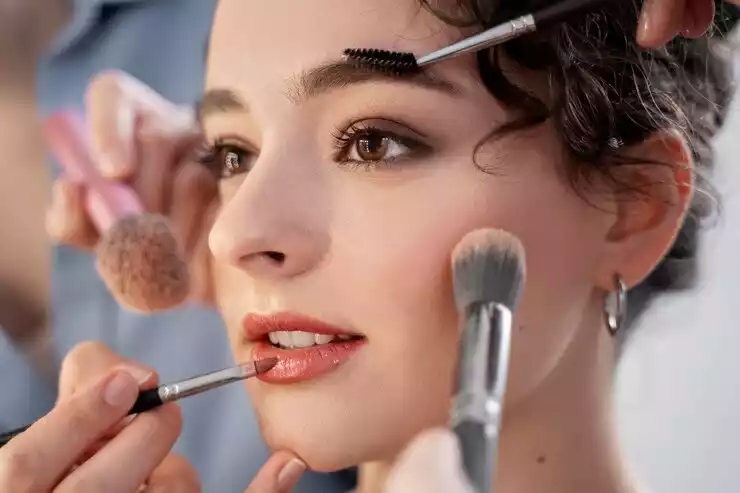Understanding Your Target Audience
![beauty-market.jpg]()
Define Your Niche
In the beauty industry, where personalisation and specialisation are key to standing out, defining your niche is crucial. A niche allows you to focus your marketing efforts on a specific part of the market, rather than trying to appeal to everyone. Identifying your niche—be it eco-friendly skincare, luxury spa treatments, or budget-friendly makeup—helps you become a go-to expert in that area. This not only makes your marketing more effective but also helps in building a loyal customer base that trusts your expertise and shares your values.
- Market Research: To truly understand your target audience, conducting thorough market research is essential. Here’s how you can get started:
- Surveys and Questionnaires: These are powerful tools to gain insights directly from your potential or existing customers. You can use online platforms like Instagram polls to ask specific questions about their preferences, buying habits, and what they’re looking for in a beauty business.
- Social Media Insights: Social media platforms offer a wealth of information about your followers and the wider audience. Tools like Instagram Insights or Twitter Analytics can reveal your audience’s demographics, peak activity times, and the type of content they engage with the most. This data can guide your content creation and posting schedule.
- Competitor Analysis: Observing your competitors can provide valuable insights into what might or might not work for your target audience. Take note of the services they offer, their marketing strategies, promotional efforts, and customer engagement on social media. This will help you identify gaps in the market and areas for improvement or differentiation in your own strategy.
Building a Strong Brand Identity
A strong brand identity is more than just a logo; it's the comprehensive image and personality your beauty business presents to the world, differentiating you from competitors and connecting with your target audience. Here's how to build a cohesive and compelling brand identity:
Brand Name and Logo
- Keep It Simple and Relatable: Your brand name should be easy to pronounce and remember. Aim for something that reflects the essence of your beauty business and resonates with your target audience.
- Be Unique: Make sure your brand name stands out. Do a thorough search to ensure it’s not already in use, especially within your industry.
- Consider Longevity: Choose a name and logo that will age well with your business, avoiding overly trendy elements that might feel outdated quickly.
- Professional Design: Invest in a professional designer for your logo. A well-designed logo not only captures attention but also creates a professional image and helps in brand recall.
Brand Voice and Values
-
Importance of consistency in communication: Consistency in your brand voice and messaging reassures your audience of your reliability and professionalism. It helps in building trust and strengthening your brand's values, whether through promotional materials, social media, or direct customer interactions. Your brand voice could be friendly, professional, quirky, or luxurious, based on your target audience and business ethos. Upholding these consistently across all platforms ensures that your business is easily recognisable, relatable, and dependable.
Packaging and Presentation
-
How does packaging impact perception?
Packaging plays a crucial role in the beauty industry not only for product protection but also in conveying your brand's message and values. High-quality, attractive packaging can significantly enhance the perceived value of your products. It's also a great opportunity to extend your brand's aesthetic and narrative, creating a memorable unboxing experience that customers love to share, especially on social media. Sustainability in packaging is increasingly becoming important to consumers, so consider environmentally friendly options that align with global sustainability trends and appeal to a conscientious audience.
Using Social Media Platforms
Choosing Platforms
- Identify Suitable Platforms: Focus on platforms where visual content thrives, such as Instagram, TikTok, and YouTube. Each of these platforms attracts large audiences looking for beauty tips, product recommendations, and style inspiration.
- Analyze Competitor Presence: Observe where your competitors invest their social media efforts. This research will help you understand where potential customers may expect to find your products and services.
- Engage with Pinterest: Don't overlook Pinterest as this platform acts like a visual search engine, ideal for tutorials and product showcases which users can save for long-term reference.
- Test and Iterate: Begin by testing different platforms to see where you gain the most engagement. Use platform analytics to measure performance and shift strategies as needed to maximize reach and engagement.
Content Strategy
- Tutorials and How-Tos: Regularly post detailed tutorials using your products. Incorporate step-by-step photos or videos to guide users through the beauty process—from basic looks to advanced techniques.
- Client Testimonials: Share video or written testimonials from happy customers. Personal stories about how your product or service has helped others can significantly influence new clients’ perceptions and decisions.
- Behind-the-Scenes: Offer a peek behind the curtain by showing your team in action, whether it's at your salon, preparing products, or setting up for an event. It helps humanize your brand and build a stronger connection with your audience.
- Schedule Consistently: Create a content calendar to maintain a consistent posting schedule that keeps your audience engaged without overwhelming them. Consistency helps build trust and anticipation among your followers.
Influencer Collaborations
- Identify Relevant Influencers: Look for influencers who align with your brand’s aesthetic, values, and target audience. Use tools like Upfluence, AspireIQ, or simply Instagram's search function to find influencers with engaged followings in the beauty sector.
- Evaluate Engagement Levels: Rather than just follower count, assess potential collaborators by engagement rate (likes, comments, shares). Influencers with high engagement rates tend to have a loyal audience that trusts their recommendations.
- Establish Clear Expectations: When reaching out to influencers, be clear about what you expect from the collaboration (e.g., number of posts, content style, timelines) and what they will receive in return (e.g., free products, payment). Transparent communication prevents misunderstandings.
- Monitor and Analyze Results: Track the performance of influencer collaborations through engagement metrics and, if possible, direct sales linked from their promoted content. Use these insights to refine future influencer strategies.
- Build Long-Term Relationships: Instead of one-off campaigns, aim to build lasting relationships with influencers. Long-term partnerships can yield more authentic endorsements and become a reliable source of repeated exposure for your brand.
Worrying about how to contact a well-known influencer? We can help you to connect with the best of the influencers for your business promotion.
![CTA-HOW-TO.png]()
Email Marketing
How to Collect More Email Addresses?
- Give Something Away: People love freebies! Offer a cool freebie like a helpful guide or a discount code in exchange for their email address.
- Signup Box on Your Website: Make sure there’s a box or button on your website where visitors can quickly sign up to hear more from you. Keep it simple and visible.
- Use Social Media: Tell your followers about the awesome stuff they’ll get if they sign up for your emails. Maybe even tease them with content they’re missing out on.
- Host a Fun Event or Contest: Organize an online contest where entering means giving their email. Everyone loves a chance to win something exciting!
- Ask During Purchase: For those selling stuff, don’t forget to ask for an email at checkout. Offer them updates on future products or exclusive deals.
Creating Engaging Newsletters
- Mix It Up: Include different types of content like tips, news, or special offers to keep things interesting. Show off new products or share a fun fact.
- Look Good on All Devices: Use designs that look great both on computers and phones. Lots of people read emails on their phones now!
- Personalise It: Make your emails feel personal like they’re just for the reader. Use their name or suggest products based on what they like.
- Clear Action Button: Want them to shop, sign up, or read more? Make it easy with a big, bold button that says exactly what to do next.
- Keep It Short and Sweet: Don’t make your newsletter a novel. Keep it short with punchy headlines and bullet points. Easy to read = more likely to read.
Promotions and Discounts
- Make It Exclusive: Use emails to offer special deals just for subscribers. It makes your list seem like a VIP club.
- Limited Time Only: Create offers that don’t last forever. A 24-hour sale or a discount that ends by the weekend can make people act fast.
- Early Access: Let email subscribers get first dibs on big sales or new products. It’s like a thank you for being on your list.
- Bundle Deals: Pair products together at a special price for your email friends. It’s a win-win: they save money, and you sell more.
- After the Sale Follow-Up: After someone grabs an offer, check in to see how they liked it. It shows you care and can lead to more sales down the line.
Utilising Local Marketing
Networking Events
- Attend Regularly: Make it a point to attend local networking events. This is where you can meet potential customers, gather insight into your community, and get your brand noticed.
- Host Your Own Events: Why wait for an event when you can create your own? Host seminars, workshops, or casual meet-ups at your location. This shows your investment in the community and attracts local media attention.
- Engage and Follow Up: Don’t just collect business cards—follow up. Send a personalized email or make a call to express your pleasure in meeting them and suggest a one-on-one further discussion.
Collaborations with Local Businesses
- Identify Synergies: Look for businesses that complement yours. If you’re a bakery, partner with a local coffee shop for combined offers.
- Joint Promotions: Launch promotions that share costs and multiply audience reach. This could be a special discount when customers purchase from both or cross-promotional social media posts.
- Shared Spaces: If physical space allows, consider co-hosting events or sharing your business space with other local businesses for pop-up events.
Local SEO
- Google My Business: Ensure your business is listed on Google My Business. Keep your profile updated with current information, pictures, and offers.
- Local Keywords: Use keywords that reflect your local area. If you’re a florist in Austin, make sure "Austin flowers" is part of your website’s text.
- Encourage Reviews: Ask happy customers to leave positive reviews online. Reviews can significantly affect your local search rankings and can sway potential customers.
Celebrity Appearances
- Reach Out to Local Influencers: Connect with local celebrities or beauty influencers who align with your brand. Offer them a compelling reason to attend your event such as a speaking slot or a VIP experience.
- Make It News-Worthy: Plan an event that offers good photo ops and interesting activities. Ensure it’s something that influencers would love to share with their followers.
- Utilise Their Reach: When you confirm a celebrity or influencer, promote their attendance in all your materials. Their fans are likely to turn out just to meet them, giving you more exposure.
Find Top Beauty Influencers To Make Celebrity Appearances At Your Event. Click Below!
![CTA-Influencer.png]()
Host Workshops and Events
Educational Workshops
- Skill-Building Sessions: Host makeup or skincare workshops to educate your customers. These can be opportunities for them to learn new techniques, get tips from professionals, and engage with your brand on a deeper level.
- Hands-On Experience: Provide a hands-on environment where attendees can try your products. This direct experience can increase customer trust and lead to higher sales.
- Create Brand Advocates: Empower your attendees by providing valuable knowledge. Satisfied learners are more likely to share their positive experiences with friends and family, spreading word-of-mouth promotion for your brand.
Product Launch Events
- Build Anticipation: Before your event, tease your new product on social media to create excitement and curiosity. Give sneak peeks or drop hints about the big reveal.
- Offer Exclusive Access: Make attendees feel special by providing first-time access to your new product. Limited-time offers or event-exclusive discounts can turn attendees into immediate customers.
- Gather Feedback Instantly: Use product launch events to get direct feedback from your most loyal customers. This information can be invaluable for future product developments and enhancements.
Virtual Events
- Choose the Right Platform: Select an online platform that aligns with your brand and is user-friendly for your audience. Whether it's Zoom, Facebook Live, or Instagram Live, ensure that it supports the kind of event you're hosting.
- Interactive Elements: Keep your audience engaged by incorporating Q&A sessions, live demos, and interactive polls. This will make the virtual event experience more enjoyable and memorable for participants.
- Wider Accessibility: Promote your virtual events early and across multiple channels to maximize attendance. The beauty of virtual events is that they are not limited by location, so you can reach a global audience.
Analyzing and Adjusting Your Marketing Strategies
Tracking Performance
- Choose Your Tools: Utilize digital tools like Google Analytics, social media insights, or specialized marketing software to track your campaign performances. These tools can provide you with valuable data on traffic, engagement, conversions, and more.
- Define Key Metrics: Identify which metrics are most relevant to your goals. This could be the number of website visitors, the engagement rate on social media posts, sales conversion rates, or customer retention percentages.
- Regular Reviews: Schedule weekly or monthly sessions to review these metrics. This allows you to monitor trends, understand what’s working, and identify areas for improvement.
Adapting Strategies
- Set Benchmarks: Establish clear benchmarks based on your initial data. These will serve as your performance standards for comparing future data.
- Be Flexible: If certain tactics are not yielding expected results, be ready to pivot. Modify your strategies based on what the data is telling you. For instance, if Instagram Stories are driving more engagement than posts, consider allocating more resources there.
- Test and Learn: Implement A/B testing to compare different strategies. This method can help you understand customer preferences better and tailor your efforts accordingly.
Staying Updated
- Industry News: Subscribe to relevant marketing and industry newsletters, podcasts, and blogs. This can help you stay ahead of emerging trends and changes in consumer behaviour.
- Attend Workshops and Seminars: Participate in industry workshops, webinars, and seminars. These can be invaluable sources of knowledge and networking opportunities.
Final Thoughts
As you embark on this journey of growth and adaptation, remember that the landscape of business and marketing is ever-changing. The willingness to learn, adapt, and innovate is what separates the successful from the stagnant. To inspire you as you move forward, consider this quote: "The secret of change is to focus all of your energy not on fighting the old, but on building the new." – Socrates
Let this be the guiding principle as you grow your beauty business.
Grab an opportunity to get a celebrity or influencer to promote your business! Talk To Us Now!
![button_talk-to-us-now.png]()
![birthday occasion]() Birthday Gifts
Birthday Gifts
![anniversary occasion]() Anniversary Gifts
Anniversary Gifts
![women]() Women
Women
![men]() Men
Men
![Couples]() Couples
Couples
![Couples]() Wedding Gifts
Wedding Gifts

 Birthday Gifts
Birthday Gifts
 Women
Women
 Men
Men
 Anniversary Gifts
Anniversary Gifts
 Wedding Gifts
Wedding Gifts
 Did you know that the global beauty industry is worth over $500 billion and is growing every year? Whether you're running a
Did you know that the global beauty industry is worth over $500 billion and is growing every year? Whether you're running a 



 We now support international payments
We now support international payments
